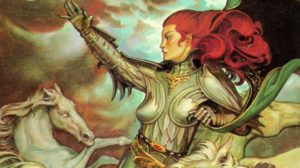 Today we shall gird our swords and prepare our spells as we journey through vengeful and vindictively verdant forests effused with purple passions under the tutelage of the most seductive, skilled, and practically perfect leader of the land of Joiry, none other than Jirel herself. Jirel, arrogant, beautiful, and skilled, has a wide background in defeating demons while looking impeccable, and will be assuming the leadership position as we traverse the mysteries of Joiry and the evolution of sword and sorcery.
Today we shall gird our swords and prepare our spells as we journey through vengeful and vindictively verdant forests effused with purple passions under the tutelage of the most seductive, skilled, and practically perfect leader of the land of Joiry, none other than Jirel herself. Jirel, arrogant, beautiful, and skilled, has a wide background in defeating demons while looking impeccable, and will be assuming the leadership position as we traverse the mysteries of Joiry and the evolution of sword and sorcery.
Our first stop is the land of adventure fiction, the birthplace of Jirel’s grandparents. Sword and sorcery drew, as a genre, from the adventure stories that preceded it, such as those by Alexander Dumas (starting in 1838), H.R. Haggard (the Allan Quartermain series, starting in 1885), and the Baroness Orczy (The Scarlet Pimpernel, 1905), which in turn drew upon the recently translated Arabian Nights (Sir Richard Burton, 1885) and Gothic to include the pretense of supernatural elements. (Although generally in these stories, the supernatural turns out to be the equivalent of a Scooby Doo villain, or is anthropomorphized, such as Rudyard Kipling’s The Jungle Book, 1894.)
From the lands of the adventure stories, we follow Jirel to Mars, of all places. In 1912, Edgar Rice Burroughs brought Jirel and Joiry closer to existence, with the publication of A Princess of Mars (which is not quite sword and sorcery, but is definitely science fantasy). A Princess of Mars is the first Barsoomian novel (of which there would go on to be seven) featuring the adventures of John Carter and his quest for the hand of the incomparable Thuvite Princess of Mars, Dejah Thoris. The books would also feature Thuvia, Maid of Mars, and her suitor, Carthoris (son of John Carter and Dejah Thoris) beginning with the spot-on title of Thuvia, Maid of Mars, which started in serial in 1916.
The pulp magazines of the 20s and on drew even further upon the supernatural, incorporating it as an integral part of the story, primarily starting with the magazine Weird Tales and the land of Cimmeria, where we meet Conan the Barbarian for the first time.
Conan was a born on a battlefield, the son of the village blacksmith, a barbarian through and through. He’s smart, he’s crafty, but most of all, he is muscular, virile, and potent, signifying the urges and desires of the true Alpha male. The first Conan story, written by pulp pop star Robert E. Howard, appeared in Weird Tales in December of 1932. The stories proved to be immensely popular and other pulps began to imitate Weird Tales, and Weird Tales (to keep up with demand) began to publish even more of these adventure stories, including those that veered to the fully supernatural (Lovecraft) and Clark Ashton Smith.
Which brings us to the land of Joiry and the leader of today’s journey, Jirel, the equal to Conan in every way; as strong, smart, and crafty as he is: the feminine version of him in physical perfection and attractiveness, but with the additional ability of womanly empathy and sympathy.
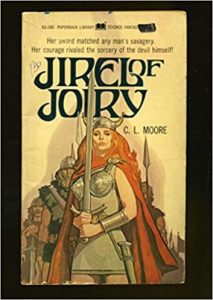 C.L. Moore made her publishing debut in Weird Tales in November 1933 with the oddly titled story “Shambleau.” Jirel showed up with “Black God’s Kiss” in 1934, and would go on to appear in six stories, later collected into book form as Jirel of Joiry in 1969.
C.L. Moore made her publishing debut in Weird Tales in November 1933 with the oddly titled story “Shambleau.” Jirel showed up with “Black God’s Kiss” in 1934, and would go on to appear in six stories, later collected into book form as Jirel of Joiry in 1969.
Jirel (and the land of Joiry) defied the medieval conventions assigned to fantasy — Jirel is a female landowner and ruler, and no man is able to force himself upon her. (If she consents, and she does, that’s a different matter.). A brazen redhead with an aristocratic viewpoint, Jirel battles sorceresses and demons, impeccably attired.
Now, while she’s over there killing something whilst looking stunning and wearing next to nothing, let’s have a bit of a chat.
Don’t you think she’s almost too perfect?
Well, yes, Jirel was born at the end of the first wave of feminism, which highlighted inequalities between the sexes, and is really one of the first second wave (which asserted that women are equal) characters. Jirel does fall into the trap of doing it all, plus some. She’s not just the equal of Conan — she’s better than him, because she uses her “womanly” skills as well as her sword. And Jirel takes much the same view of men as Conan does of women, which is that men exist to either be defeated, subservient, or are available for fornication.
For that, I rather adore her, even if I find her physical beauty rather intimidating and her clothing choices lamentably skimpy. The focus of all six Jirel stories are her willpower and emotional receptivity.
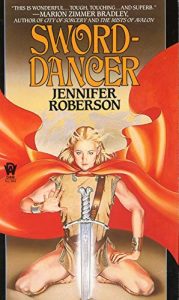 And as one of the first writers in a fledgling genre, Jirel remains a vital influence of the sword and sorcery genre, even if the genre didn’t get a name until 1961 when Fritz Leiber coined the term.
And as one of the first writers in a fledgling genre, Jirel remains a vital influence of the sword and sorcery genre, even if the genre didn’t get a name until 1961 when Fritz Leiber coined the term.
The genre as a whole would go on to be immensely popular in the 80’s and Jirel became the elder sister of Marion Zimmer Bradley’s Amazon Renunciates of Darkover and Jennifer Roberson’s Tiger and Del of the Sword-Dancer Saga. Xena, Warrior Princess is another one of her nieces in terms of lineage.
So before we leave the land of Joiry and journey onto our respective perilous pebbled roads, let us salute the First Lady of Sword and Sorcery, Jirel, who paved the path for women with weapons fighting the good fight against darkness on the Map of Speculative Fiction.




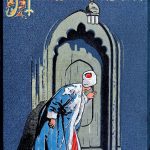
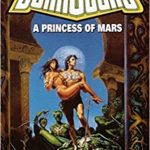


No Comments